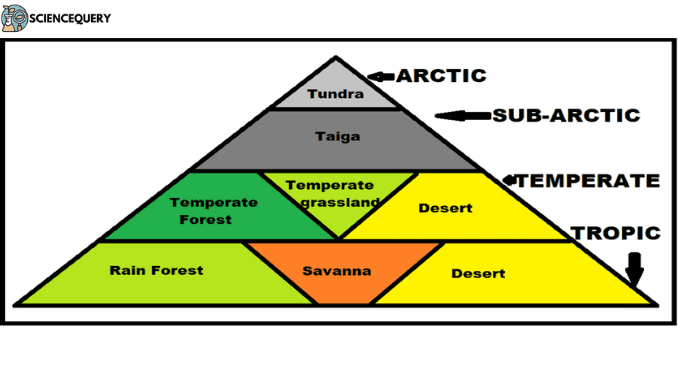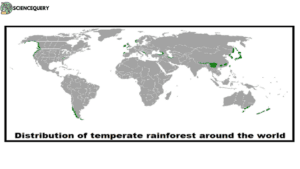
Introduction
Biome is a major climax community of plants and animals. It generally corresponds to a climatic region. According to F.E Clements and V.S.Shelford, “ Biome is defined as a biotic community of geographical extent characterized by distinctiveness in the life forms of the important climax species.”
Each biome usually is named for its dominant vegetation.
Types of Biome
There are 7 major types in the world.
1. Forest Biome
This spans a great climatic range, from wet equatorial to cold subarctic. The major classes include-
-
Equatorial and Tropical Rainforest
These forests are found in the equatorial and tropical latitude zones. They experience high temperatures and abundant rainfall throughout the year. The forest comprises tall trees, and the crowns of the trees form a canopy. Various animals like monkeys, lemurs, and lizards are found.

-
Temperate Rainforest
This biome is famous for its green forest at middle and high latitudes, growing along the narrow margins of the Pacific Northeast in North America. The trees are tall, ranging from 60-90m. Temperate forests on different continents have different species.

2. Savanna Biome
This biotic region consists of a combination of trees and grasslands in various proportions.
-
Tropical Savanna
It lies in the transition belt between tropical rainforests steppes and deserts. The largest region of this biome is the Sahel region and the Serengeti plains in Africa. Various animals like giraffes, zebras, lions, and elephants are found.

3. Grassland Biome
This biotic region consists of upland vegetation largely or entirely of herbs, which includes grasses, grasslike plants, and forbs.
-
Mid-Latitude grasslands
They differ from tropical savannas because here they lack scattered trees or bushes except along rivers or streams. In this biome, the grasses are shallow-rooted and the underground parts tend to form a matted turf that checks the penetration of rainwater to deeper layers. They are found in South America, North America, Africa, and Asia.

4. Desert Biome
These are associated with climates of extreme aridity, thinly dispersed plants, and bare ground.
-
Warm and semi-desert biome
They exist where available moisture is low. They are located around the tropics because of high temperatures. The semi-desert shrub is found on the dry side of the tropical thorn forest. They are mainly found in Chile, Western Sahara, and Namibia.
-
Cold and Semi-desert
It is found at higher latitudes. They are located in rain-shadow areas of mountains. The amount of rainfall in this biome is usually sufficient to support a vegetation cover of short grasses.

5. Arctic and Alpine Tundra Biome
The arctic tundra biome lies in the constantly cold conditions poleward of the montane forest. Climatic conditions are so adverse that the tundra region is inhospitable for human habitation and most other organisms. Under these conditions, the natural vegetation is in the form of mosses and lichens. The arctic and alpine tundras are visited by grazing animals during the short summer months like reindeer, caribou, mux ox, mountain sheep, etc. The alpine tundra biome can occur in lower latitudes near mountains such as the white mountains of California, the Rockies, the Alps Mt. Kilimanjaro, etc.

Q&A
1. What is a biome in simple definition?
Biomes are very large ecological areas on the earth’s surface, with fauna and flora adapting to their environment.
2. What is a biome explained for kids?
Biomes are regions of the world with similar climates, animals, and plants.
3. What is the difference between biome and ecosystem?
The few major differences are as follows
Biome |
Ecosystem |
|
|
|
|
|
|
4. What are the 7 major types of biomes?
The seven major types of biomes present in the world are-
- Equatorial and tropical rainforest.
- Tropical savanna.
- Temperate rainforest.
- Mid-latitude grasslands.
- Warm and cold desert.
- Arctic tundra.
- Alpine tundra.
Summary
- Biomes are the world’s major communities classified according to the predominant vegetation and characterized by adaptations of organisms to that particular environment.
- Different environmental factors play a role in determining which biomes are found where.
- Biomes generally differ in their latitude, weather, relative humidity, amount of sunlight, and topography.
- Each biome has a unique set of plants and animals that thrive in its climate.
- Similar biomes can occur in widely divergent places as long as the environmental conditions are appropriate for their development.
- There are seven major biomes in the world.
- Major biomes include rainforests, deserts, grasslands, tundras, and temperate forests.
- These ecosystems play a crucial role in maintaining global ecological balance and provide habitat for a wide variety of species.
References
- D.S.Lal. Physical Geography. Sharda Pustak Bhavan, Allahabad. Chapter 56- Biome, Page no- 774-780.
- Rajiv Ahir. Spectrums Geography.Spectrum Books Pvt.Ltd, New Delhi. Chapter 201-Major biotic regions of the world. Page no: 242-251.
- https://d43fweuh3sg51.cloudfront.net/media/assets/wgbh/tdc02/tdc02_doc_biomesummary/tdc02_doc_biomesummary.pdf
Written By: Ankita Gangopadhaya
